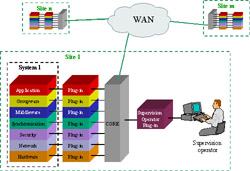| Full name: | Generic Systems Supervision |
| Number: | IST-2001-34162 |
| Start date: | 2002. 01. 03. |
| End date: | 2004. 31. 08. |
| Participants: |
|
| Cost: | 2.61 million EURO |
| Project homepage: | http://genesys.sztaki.hu |
Project objectives
The GeneSyS (Generic Systems Supervision) mission statement is:
To enhance distributed systems and applications with a generic and standardised supervision solution and nurture its practical implementation and multi-sector exploitation as a key enabler for the competitiveness of European research and industry.
The top-level objectives of the GeneSyS project are:
- To specify and develop an open, generic, modular and comprehensive supervision concept,
- To integrate and validate this supervision structure within various industrial contexts,
- To achieve the adoption of the GeneSyS concepts by all stakeholders (internal and external to the consortium), and to ensure that the vision of the proposed generic structure will become a new emerging standard.
The first objective is aimed at specifying and developing a new supervision middleware for distributed systems and applications, as the need for a global and generic supervision solution has arisen among various industries in different domains such as space, maritime, medical, automotive and e-business ones. In fact, today solutions are mainly focusing on the supervision of low levels of a distributed system, i.e. hardware and network availability and monitoring. But these systems are becoming more and more complex and therefore, they need to be supervised in a new way:
- The supervision shall implement the control and monitoring not only of low level but also of higher levels (i.e. application, QoS, GroupWare, ...) of the distributed system.
- The global supervision shall range from a passive monitoring of the resources to an active control of the applications running over these distributed systems.
- The supervision shall be applicable to a various set of different distributed systems and applications, i.e. it must be generic and open.
The GeneSyS project will be decomposed in two phases leading to two versions of the product. The methodology for these two rounds will be the same : the definition of the solution will be the result of a user requirement elicitation process which will be faced to the results of a state-of-the-art study. The concept of Validation Scenario (existing distributed applications coming from concrete industrial contexts) will support the requirement analysis and an evaluation process will be set-up in order to assess the benefits of the solution against end-user objectives. From that synthesis, the services offered by GeneSyS will be expressed, and the supervision architecture will be proposed with the way to integrate it within the considered distributed system. A prototype will be developed, implementing most of the significant supervision services.
The achievement of the first objective will be assessed by the production of key documents and a prototype submitted to reviews. The project will produce for both versions:
- a state-of-the-art analysis,
- the description of the Validation Scenarios (including the evaluation criteria),
- the GeneSyS architecture,
- the prototype software,
- the development report.
Moreover, the GeneSyS middleware architecture and the development will be the major technical items submitted to the first, second and fourth reviews.
The second objective has to achieve a validation of the deployment and the use of the supervision solution, with an assessment of the benefits of GeneSyS-based distributed application in an international, tool- & network-heterogeneous, system environment.
Relevant and realistic scenarios based on real user-cases of the industry will support the validation process. They will be inspired by several complementary industrial domains:
- The "distributed simulation" domain supervising typical exercises of distributed group training,
- The "distributed engineering" domain will be addressed by typical applications of collaborative design and non collocated project reviews,
- The "e-business domain" supervising distributed e-commerce web services.
After the definition of the Validation Scenarios, the GeneSyS middleware and the application entities will be deployed over international networks. It will require the availability of public and private networks. The plat-forms will be set-up taking into account the different validation contexts. The application software and data required by the validation process will not be developed , these software will be re-used from existing applications. GeneSyS capability to be integrated within existing application software will be also evaluated as well as the communication within networks of different topologies : point-to-point, multi-point or broadcast. During the performance of the validation scenarios, the evaluation process will be applied to precisely assess the validation results and GeneSyS benefits.
The deployment of an initial version (V1), followed by a fully engineered one (V2), will ensure that users feedback will be implemented and that a full-scale set of trials can be conducted.
The project will produce:
- 3 deployed, set-up and tested platforms (one per validation scenario),
- a validation report (including the integration report and the evaluation results).
Moreover, the results of this concrete experiments will be submitted to the third and fifth reviews.
The third objective consists in the dissemination, the exploitation and the standardisation of the GeneSyS concepts and technologies:
The dissemination will start since the beginning of the project. GeneSyS concepts, technologies and results will be shown to a large community of stakeholders mainly by means of conferences and workshops. A modular package including the GeneSyS middleware and/or several Plug-ins and a Software User Manual (SUM) will support these dissemination activities.
The open source middleware initiative aiming at developing the GeneSyS middleware under an open-source license will offer several benefits by facilitating the dissemination through a large audience of universities, by being supported by a large community of developers and by enabling the easy integration of third party commercial supervision products without the usual "competition" problems.
This open-source aspect will be completed by the creation and the management of a Supervision Interest Group. The purpose will be to set-up a dynamic, large and professional network of industries and organisations sharing the same interests for GeneSyS related technologies and perspectives, and ultimately to better support the advanced concepts.
The exploitation of the GeneSyS results by partners will be described in exploitation plans (at partner level and at consortium level). The dissemination feedback will allow to progressively establish a Business Plan and to consolidate the market demand in term of technical requirements as well as in term of price, to better know the potential competitors, and, of course, to identify prospects and to motivate them to further purchase GeneSyS.
The project will produce:
- Dissemination material (Web site, CD-ROM, brochure, newsletter),
- Dissemination Report,
- Standardisation Reports,
- Dissemination & Use Plan,
- Technology Implementation Plan,
- Business Plan,
- Partner Exploitation Plans.
GeneSys Middleware
The purpose of the GeneSyS middleware is to improve the communication infrastructure by introducing several new concepts:
- The generic aspect of the GeneSyS middleware solution,
- The development strategy as an open source project,
- The implementation of communications without use of a central repository.
The generic aspect of the GeneSyS middleware will be ensured by basing the communication infrastructure on IP level in order to be independent of the network technology.
The open source initiative will offer several benefits compared to standard commercial products which are mainly proprietary:
- The dissemination will be easier and a large audience can be expected with universities.
- The project will be supported by a large community of developers.
Multiple third party commercial supervision products can be integrated without usual "competition" problems.
Most of existing middleware available on the market are using the service of a central repository where resides all the information about the nodes available on the network:
- Use of a repository at a low level layer (means communication layer) produces a complex management issues : dedicated servers, replication, synchronisation, fault tolerance... This complexity is not needed while the major service expected is resumed in the establishment of a communication from a point to another point of the network.
- A majority of third party supervision products are using a repository at application level : a second level of repository would be useless.
This situation makes non appropriate the use of these products for distributed systems supervision and confirms the interest for the GeneSyS solution : GeneSyS middleware will provide simple "point to point" and "publish and subscribe" mechanism without the need of a global repository. This will guarantee maximum simplicity and efficiency for exchanging information between any client applications.

